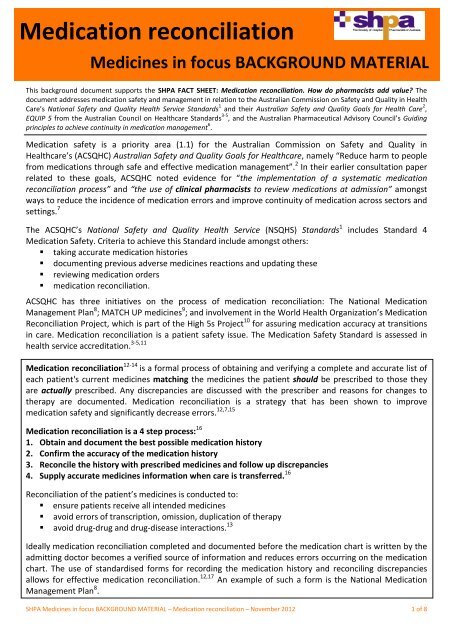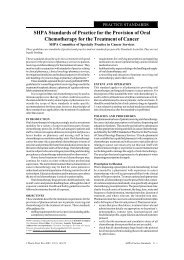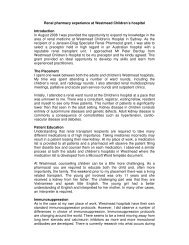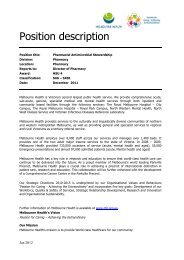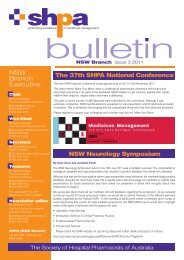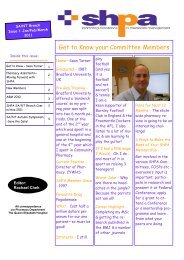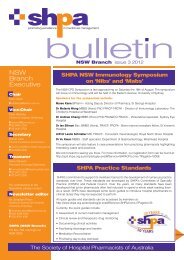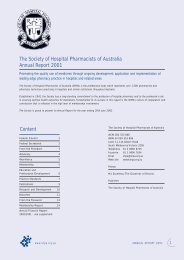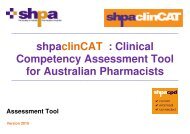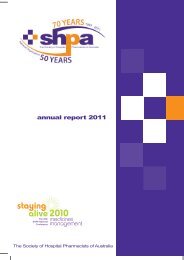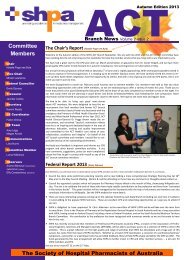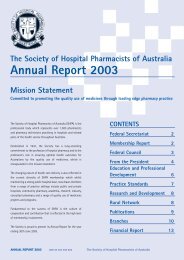references and background material - The Society of Hospital ...
references and background material - The Society of Hospital ...
references and background material - The Society of Hospital ...
You also want an ePaper? Increase the reach of your titles
YUMPU automatically turns print PDFs into web optimized ePapers that Google loves.
Medication reconciliation<br />
Medicines in focus BACKGROUND MATERIAL<br />
This <strong>background</strong> document supports the SHPA FACT SHEET: Medication reconciliation. How do pharmacists add value <strong>The</strong><br />
document addresses medication safety <strong>and</strong> management in relation to the Australian Commission on Safety <strong>and</strong> Quality in Health<br />
Care’s National Safety <strong>and</strong> Quality Health Service St<strong>and</strong>ards 1 <strong>and</strong> their Australian Safety <strong>and</strong> Quality Goals for Health Care 2 ,<br />
EQUIP 5 from the Australian Council on Healthcare St<strong>and</strong>ards 3-5 , <strong>and</strong> the Australian Pharmaceutical Advisory Council’s Guiding<br />
principles to achieve continuity in medication management 6 .<br />
Medication safety is a priority area (1.1) for the Australian Commission on Safety <strong>and</strong> Quality in<br />
Healthcare’s (ACSQHC) Australian Safety <strong>and</strong> Quality Goals for Healthcare, namely “Reduce harm to people<br />
from medications through safe <strong>and</strong> effective medication management”. 2 In their earlier consultation paper<br />
related to these goals, ACSQHC noted evidence for “the implementation <strong>of</strong> a systematic medication<br />
reconciliation process” <strong>and</strong> “the use <strong>of</strong> clinical pharmacists to review medications at admission” amongst<br />
ways to reduce the incidence <strong>of</strong> medication errors <strong>and</strong> improve continuity <strong>of</strong> medication across sectors <strong>and</strong><br />
settings. 7<br />
<strong>The</strong> ACSQHC’s National Safety <strong>and</strong> Quality Health Service (NSQHS) St<strong>and</strong>ards 1 includes St<strong>and</strong>ard 4<br />
Medication Safety. Criteria to achieve this St<strong>and</strong>ard include amongst others:<br />
• taking accurate medication histories<br />
• documenting previous adverse medicines reactions <strong>and</strong> updating these<br />
• reviewing medication orders<br />
• medication reconciliation.<br />
ACSQHC has three initiatives on the process <strong>of</strong> medication reconciliation: <strong>The</strong> National Medication<br />
Management Plan 8 ; MATCH UP medicines 9 ; <strong>and</strong> involvement in the World Health Organization’s Medication<br />
Reconciliation Project, which is part <strong>of</strong> the High 5s Project 10 for assuring medication accuracy at transitions<br />
in care. Medication reconciliation is a patient safety issue. <strong>The</strong> Medication Safety St<strong>and</strong>ard is assessed in<br />
health service accreditation. 3-5,11<br />
Medication reconciliation 12-14 is a formal process <strong>of</strong> obtaining <strong>and</strong> verifying a complete <strong>and</strong> accurate list <strong>of</strong><br />
each patient's current medicines matching the medicines the patient should be prescribed to those they<br />
are actually prescribed. Any discrepancies are discussed with the prescriber <strong>and</strong> reasons for changes to<br />
therapy are documented. Medication reconciliation is a strategy that has been shown to improve<br />
medication safety <strong>and</strong> significantly decrease errors. 12,7,15<br />
Medication reconciliation is a 4 step process: 16<br />
1. Obtain <strong>and</strong> document the best possible medication history<br />
2. Confirm the accuracy <strong>of</strong> the medication history<br />
3. Reconcile the history with prescribed medicines <strong>and</strong> follow up discrepancies<br />
4. Supply accurate medicines information when care is transferred. 16<br />
Reconciliation <strong>of</strong> the patient’s medicines is conducted to:<br />
• ensure patients receive all intended medicines<br />
• avoid errors <strong>of</strong> transcription, omission, duplication <strong>of</strong> therapy<br />
• avoid drug-drug <strong>and</strong> drug-disease interactions. 13<br />
Ideally medication reconciliation completed <strong>and</strong> documented before the medication chart is written by the<br />
admitting doctor becomes a verified source <strong>of</strong> information <strong>and</strong> reduces errors occurring on the medication<br />
chart. <strong>The</strong> use <strong>of</strong> st<strong>and</strong>ardised forms for recording the medication history <strong>and</strong> reconciling discrepancies<br />
allows for effective medication reconciliation. 12,17 An example <strong>of</strong> such a form is the National Medication<br />
Management Plan 8 .<br />
SHPA Medicines in focus BACKGROUND MATERIAL – Medication reconciliation – November 2012 1 <strong>of</strong> 8
Medicines are the most common treatment used in health care <strong>and</strong> are associated with a higher<br />
incidence <strong>of</strong> errors <strong>and</strong> adverse events than other healthcare interventions. 1<br />
It is estimated that in Australia, 190 000 hospital admissions a year are medication related with the cost <strong>of</strong><br />
these estimated at $660 million 1,18 <strong>and</strong> at least 400 000 visits to general practitioners are associated with<br />
adverse events from medicines. 1 Errors can occur at all interfaces <strong>of</strong> care. 12<br />
Estimates <strong>of</strong> preventability for medication-related hospital admissions <strong>and</strong> adverse drug reactions<br />
associated with hospitalisation suggest that between one third <strong>and</strong> three quarters are potentially<br />
preventable. 18<br />
<strong>The</strong>re are increasing numbers <strong>of</strong> older people in the community with chronic complex health conditions.<br />
Many are on multiple medicines, sometimes from a variety <strong>of</strong> prescribers <strong>and</strong> sources. Medication<br />
management for these people is <strong>of</strong>ten complex <strong>and</strong> challenging. <strong>The</strong>se patients are amongst those who<br />
would benefit from the process <strong>of</strong> medication reconciliation <strong>and</strong> review throughout their care.<br />
<strong>The</strong> Australian Pharmaceutical Advisory Council’s (APAC) Guiding principles to Achieve Continuity in<br />
Medication Management highlights the components <strong>of</strong> the medicines management pathway critical to<br />
achieving continuity in the medication management continuum. 6 Meeting APAC guidelines is a requirement<br />
for maintaining access to the PBS in hospitals.<br />
In 2008 a NSW Special Commission <strong>of</strong> Inquiry report recommended “guidelines which involve consultation<br />
by <strong>and</strong> the participation <strong>of</strong> clinical pharmacists in patient care at the earliest appropriate opportunity.... to<br />
enable a clinical pharmacist to take a patient’s medication history, participate in ward rounds, review the<br />
patient’s medical chart during their inpatient stay <strong>and</strong> review medications on discharge.” 19<br />
Medication reconciliation involves organisational, individual health service provider, <strong>and</strong> patient<br />
commitment, communication <strong>and</strong> teamwork. 12 It should be delivered to all patients, but in particular those<br />
identified at risk, for instance, in transition or as a result <strong>of</strong> changes in their medical condition.<br />
<strong>The</strong> ACSQHC Safety <strong>and</strong> Quality Goals 2 Priority area 1.1 Medication Safety, lists examples <strong>of</strong> risk factors<br />
which predispose people to medication related adverse events/harm:<br />
• currently taking five or more regular medications<br />
• taking more than 12 doses <strong>of</strong> medication per day<br />
• significant changes made to medication treatment regimen in the last three months<br />
• medication with a narrow therapeutic index or medications requiring therapeutic monitoring<br />
• symptoms suggestive <strong>of</strong> an adverse drug reaction<br />
• suboptimal response to treatment with medicines<br />
• suspected non-compliance or inability to manage medication related therapeutic devices<br />
• patients having difficulty managing their own medicines because <strong>of</strong> literacy or language<br />
difficulties, dexterity problems or impaired sight, confusion/ dementia or other cognitive<br />
difficulties<br />
• patients attending a number <strong>of</strong> different doctors, both general practitioners <strong>and</strong> specialists<br />
• recent discharge from a facility / hospital (in the last four weeks). 2<br />
SHPA Medicines in focus BACKGROUND MATERIAL – Medication reconciliation – November 2012 2 <strong>of</strong> 8
Medication review <strong>and</strong> reconciliation should be undertaken whenever the patient is transferred from one<br />
setting to another, whether within the facility or on discharge. <strong>The</strong> activities that are essential for safe <strong>and</strong><br />
effective medication management are:<br />
• medication reconciliation (including an accurate medication history or obtaining a best possible<br />
medication history which is then confirmed using a second source 9 ) on admission/ transfer into<br />
hospital <strong>and</strong> transfer (clinical h<strong>and</strong>over) between units<br />
• management <strong>of</strong> medication issues throughout the admission<br />
• medication reconciliation on discharge/ transfer from hospital <strong>and</strong> provision <strong>of</strong> that verified<br />
information for ongoing care. 1,12,13 (Figure 1)<br />
<strong>The</strong>se activities align with the Australian Charter <strong>of</strong> Healthcare Rights, in particular the patient’s right to<br />
receive safe <strong>and</strong> high quality care. 45<br />
Figure 1 Medication review <strong>and</strong> reconciliation pathway<br />
<strong>The</strong> NSQHS St<strong>and</strong>ard 4 Safety <strong>and</strong> Quality Improvement Guide 17 mentions the use <strong>of</strong> indicators such as 6.2<br />
Percentage <strong>of</strong> patients that are reviewed by a clinical pharmacist within one day <strong>of</strong> admission (Indicators for<br />
Quality Use <strong>of</strong> Medicines in Australian <strong>Hospital</strong>s) 20 as outputs in the improvement process to “implement a<br />
formal systematic process for obtaining <strong>and</strong> recording a best possible medication history”.<br />
At all points <strong>of</strong> care, medication reconciliation supports safe, timely <strong>and</strong> efficient transition <strong>of</strong> patients<br />
through the hospital <strong>and</strong> on discharge, maintaining the continuum <strong>of</strong> care. 6<br />
Pharmacists are medicines experts <strong>and</strong> skilled, effective 21,22 <strong>and</strong> efficient at providing these services. <strong>The</strong>y<br />
are also able to educate, train <strong>and</strong> support other health pr<strong>of</strong>essionals in the healthcare team to conduct<br />
comprehensive, structured medication reconciliation.<br />
Medication review <strong>and</strong> reconciliation continues when patients are returned to community care <strong>and</strong><br />
reviewed by their GP/medical specialist/healthcare provider, on transfer to an aged care facility or to<br />
another hospital, or during Home Medicines Reviews (Figure 1). <strong>The</strong> medicines management cycle<br />
associated with each episode <strong>of</strong> care, independent <strong>of</strong> the setting, is shown in Figure 2. 6,23<br />
SHPA Medicines in focus BACKGROUND MATERIAL – Medication reconciliation – November 2012 3 <strong>of</strong> 8
Effective<br />
communication <strong>of</strong><br />
accurate, complete<br />
<strong>and</strong> comprehensive<br />
information<br />
Decision on<br />
appropriate treatment<br />
Transfer <strong>of</strong> verified<br />
information<br />
Decision to<br />
prescribe<br />
medicine<br />
Medicines procurement<br />
<strong>and</strong> <strong>material</strong>s management<br />
(including formulary management,<br />
Drug & <strong>The</strong>rapeutics Committee)<br />
Record medicine<br />
order (prescribe)<br />
Monitor for<br />
response<br />
Administration<br />
<strong>of</strong> medicine<br />
(re-assessment, preparation,<br />
administration <strong>and</strong> recording)<br />
Consumer<br />
Review <strong>of</strong><br />
medicine order<br />
Issue <strong>of</strong> medicine<br />
Distribution<br />
<strong>and</strong> storage<br />
<strong>of</strong> medicine<br />
Provision <strong>of</strong><br />
medicine<br />
information<br />
<strong>The</strong> Medicines Management Pathway<br />
Stowasser DA, Allinson YM, O’Leary KM<br />
J Pharm Pract Res 2004;34:293-6<br />
Data collection <strong>and</strong> reporting, audit<br />
review <strong>of</strong> quality <strong>and</strong> safety<br />
Figure 2 Overview <strong>of</strong> the medicines management pathway cycle (reproduced from J Pharm Pract Res 2004; 34: 294.) 23<br />
When the care <strong>of</strong> the patient is transferred a current <strong>and</strong> accurate list <strong>of</strong> medicines, including reasons for<br />
change, is provided to the people taking over the patient's care <strong>and</strong> to the patient or carer.<br />
Although accurate medication histories are vitally important to optimal patient care, obtaining them can<br />
be complex <strong>and</strong> time consuming. Evidence suggests this task is poorly done by staff that are not focused<br />
on medication management 22,24-6 <strong>and</strong> that pharmacists obtain more accurate medication histories than<br />
do other health pr<strong>of</strong>essionals. 22 Pharmacists have demonstrated that they are skilled <strong>and</strong> accurate in<br />
undertaking this task 21,22 <strong>and</strong> it is valued by doctors. 27<br />
<strong>The</strong> average time taken for a clinical pharmacist to undertake a medication history interview <strong>and</strong><br />
medication reconciliation has been reported as 9.6 minutes ± 4.9 28 , <strong>and</strong> 11.3 minutes for medication history<br />
interview in a recent Australian study 29 . An earlier overseas study reported the average time taken for a<br />
pharmacist to take the medication history was 13.4 ± 6.7 minutes as compared with nurses spending on<br />
average 24.3 ± 19.8 minutes. 30,13 A separate study describing the implementation <strong>of</strong> a comprehensive<br />
medication reconciliation program at a US Academic Medical Centre noted an average time <strong>of</strong> 21.9 minutes<br />
for pharmacists to complete a medication history <strong>and</strong> 9.8 minutes to reconcile admission medications. 31 A<br />
Canadian study reported a median time required to conduct medication reconciliation at admission as 15<br />
minute (interquartile range 10-21). 32 Factors such as complexity <strong>of</strong> medication regimes <strong>and</strong> medical<br />
conditions would contribute to <strong>and</strong> account for variations in the times for these activities to be undertaken.<br />
Most hospitals in Australia with a pharmacy service <strong>of</strong>fer some level <strong>of</strong> clinical pharmacy service at the<br />
patient bedside. 33,34 An Australian study conducted across eight major teaching hospitals found that clinical<br />
pharmacist initiated changes to patient drug therapy or management contributed to reduced length <strong>of</strong> stay,<br />
reduced potential for readmission <strong>and</strong> associated savings in cost <strong>of</strong> care. 35<br />
International studies <strong>of</strong> hospital pharmacy services have shown that mortality 36,37 , adverse drug events <strong>and</strong><br />
medication errors can be reduced where clinical pharmacists work as part <strong>of</strong> health care teams. 36-39 Research<br />
from the US has found that admission drug/ medication histories <strong>and</strong> adverse drug reaction monitoring are<br />
amongst select clinical pharmacy services associated with reduced hospital mortality rates <strong>and</strong> decreased<br />
medication errors. 36,39<br />
SHPA Medicines in focus BACKGROUND MATERIAL – Medication reconciliation – November 2012 4 <strong>of</strong> 8
KEY POINTS<br />
Medication reconciliation:<br />
1. is a requirement for meeting national Medication Safety St<strong>and</strong>ards. 1<br />
2. can significantly decrease medication errors <strong>and</strong> is recognised as a key strategy towards improving<br />
medication safety <strong>and</strong> reducing morbidity <strong>and</strong> mortality<br />
3. should be delivered to all patients but in particular those identified at risk <strong>of</strong> medication<br />
misadventure: in transition, or as a result <strong>of</strong> changes in their medical condition<br />
4. has been shown to promote safe <strong>and</strong> effective use <strong>of</strong> medicines.<br />
5. requires organisational, individual health service provider, <strong>and</strong> patient commitment,<br />
communication <strong>and</strong> teamwork<br />
Evidence shows pharmacists do medication reconciliation well.<br />
Some examples <strong>of</strong> research related to medication reconciliation<br />
Australian experience<br />
In 2002, patients seen by an ED pharmacist at a metropolitan teaching hospital ‘received a more appropriate initial medication<br />
regimen as reflected by a 75% reduction in the number <strong>of</strong> changes that the ward pharmacists had to make to the admission<br />
regimen’. Documentation <strong>of</strong> adverse drug reactions increased, pain management was provided earlier <strong>and</strong> concordance with<br />
antibiotic guidelines increased with involvement <strong>of</strong> an ED pharmacist. Satisfaction levels were high amongst ED staff <strong>and</strong><br />
patients. 27<br />
Pharmacist charting <strong>of</strong> medication histories was compared with eliciting histories in the ED after medications had been<br />
prescribed by doctors at a teaching hospital in Australia. <strong>The</strong> study found that accuracy increased when the pharmacist prepared<br />
the medication charts (for the doctor), reducing the frequency <strong>of</strong> an unintentional discrepancy. <strong>The</strong> study supports early<br />
involvement <strong>of</strong> pharmacists in compiling medication histories for medication chart preparation. 40<br />
An evaluation <strong>of</strong> a medication liaison service (MLS) was conducted in two major hospitals in Australia. <strong>The</strong> interventions involved<br />
a comprehensive medication history determined at admission confirming this with the admitting doctor <strong>and</strong> community<br />
healthcare pr<strong>of</strong>essionals. On discharge a comprehensive discharge communication was prepared with the hospital medical staff<br />
<strong>and</strong> forwarded to the patient’s GP <strong>and</strong> community pharmacy. <strong>The</strong> MLS resulted in improved patient outcomes, more<br />
interventions <strong>and</strong> medication changes to optimise therapy. <strong>The</strong>re was a significant decrease in community healthcare<br />
pr<strong>of</strong>essional visits <strong>and</strong> a tendency (not-significant) for reduced readmissions. 21<br />
A review <strong>of</strong> the literature highlighted strategies for improving medication reconciliation which include: use <strong>of</strong> a st<strong>and</strong>ardised<br />
medication reconciliation form, improved communication, a multidisciplinary approach, the use <strong>of</strong> computerised physician or<br />
prescriber order entry with decision support <strong>and</strong> home medication lists. 15<br />
A study to determine time required providing clinical pharmacy services to individual medical <strong>and</strong> surgical patients at two general<br />
hospitals, <strong>and</strong> the effect <strong>of</strong> complexity <strong>and</strong> presentation on this, found that the average time to undertake a medication history<br />
interview <strong>and</strong> medication reconciliation was 9.6 minutes (st<strong>and</strong>ard deviation 4.9). 28<br />
A continuous observational time-<strong>and</strong>-motion study to quantify time clinical pharmacists spend on various activities over their<br />
working day at a teaching hospital found pharmacist conducted medication history interviews took on average 11.3 minutes <strong>and</strong><br />
medication order review 2 to 3 minutes. 29<br />
A study at a metropolitan teaching hospital in Australia found the ED pharmacist providing timely medication histories was more<br />
likely to result in admitted patients receiving an accurate medication chart early in their hospital stay. Having a clinical pharmacist<br />
within the ED resulted in a greater than 70% relative reduction in errors. 41<br />
Overseas experience<br />
A study to identify discrepancies between medication histories taken by ED providers: physicians, nurses <strong>and</strong> medical students<br />
<strong>and</strong> clinical pharmacists in a tertiary care teaching facility found that the medication histories taken by clinical pharmacists were<br />
more complete than those by the other health pr<strong>of</strong>essionals. 22<br />
A 2010 systematic review examining the effects <strong>of</strong> US pharmacist – provided direct patient care noted that mortality,<br />
hospitalisation/ readmission, inpatient length <strong>of</strong> stay, <strong>and</strong> ED visits benefit greatly from pharmacist services as do safety outcomes<br />
which include adverse drug events <strong>and</strong> medication errors. 42<br />
SHPA Medicines in focus BACKGROUND MATERIAL – Medication reconciliation – November 2012 5 <strong>of</strong> 8
In the US, research has found that pharmacy staffing, clinical pharmacy services which include pharmacist-provided admission<br />
drug histories, in-service education, adverse drug reaction management, drug use evaluation <strong>and</strong> drug protocol management<br />
were associated with reduced mortality rates. 36<br />
A study into clinical pharmacy services, hospital pharmacy staffing <strong>and</strong> medication errors in US hospitals list pharmacist-provided<br />
drug admission histories <strong>and</strong> increased staffing levels <strong>of</strong> clinical pharmacists amongst factors associated with decreased<br />
medication errors. 39<br />
A study <strong>of</strong> 49 National Health Service organisations in the UK found an association between the number <strong>of</strong> pharmacists employed<br />
(more pharmacists on staff <strong>and</strong> involved in clinical activities) <strong>and</strong> lower mortality rates. 37<br />
A study in two medical wards in a Swedish hospital using integrated medicines management–based medication reconciliation<br />
found that approximately 50% <strong>of</strong> mainly older patients were affected by errors in the medication history at admission to hospital.<br />
<strong>The</strong> most common medication error was an omitted drug, followed by a wrong dose. <strong>The</strong> authors concluded that clinical<br />
pharmacists can be valuable in performing structured medication reconciliations to reduce risk <strong>of</strong> medication errors. 43<br />
A systematic review into frequency, type <strong>and</strong> clinical importance <strong>of</strong> medication errors at hospital admission found prescription<br />
medication history errors on hospital admission are common. Improved physician training, accessible community pharmacy<br />
databases <strong>and</strong> closer teamwork between patients, physicians <strong>and</strong> pharmacists could reduce the frequency <strong>of</strong> these errors. <strong>The</strong><br />
authors indicate a need for a systematic approach to ensure acquisition <strong>of</strong> accurate medication histories at admission. 25<br />
Implementation <strong>of</strong> a comprehensive medication reconciliation program (from admission to discharge) at an academic medical<br />
centre in the US found that the pharmacy-driven multidisciplinary admission history <strong>and</strong> medication reconciliation process for all<br />
admitted inpatients reduced medication errors. All components <strong>of</strong> the medication history were documented using an integrated<br />
electronic medical record medication documentation tool. 31<br />
A pilot study conducted in an inpatient family medicine unit <strong>of</strong> an academic hospital centre in the US found that there was a<br />
decrease in the mean number <strong>of</strong> medication discrepancies that occurred during admission <strong>and</strong> discharge after a structured<br />
multidisciplinary medication reconciliation process was implemented. 41 In this study nurses spent a mean <strong>of</strong> 8.2 minutes in the<br />
first phase <strong>of</strong> the study (admission medication history-using information from medication bottles, patients, family members) <strong>and</strong><br />
5 minutes in the second phase, obtaining <strong>and</strong> documenting each patient’s medication history. During the study pharmacists had<br />
to enhance the quality <strong>of</strong> nursing medication lists with additional information on several occasions. 44<br />
A small study into the potential impact <strong>of</strong> a medication reconciliation process in a Canadian community hospital found that<br />
medication reconciliation was a useful method for identifying <strong>and</strong> rectifying medication errors at times <strong>of</strong> transition. <strong>The</strong><br />
researchers found unintended medication variances on admission <strong>and</strong> discharge are common <strong>and</strong> clinically important. 32<br />
References:<br />
1. Australian Commission on Safety <strong>and</strong> Quality in Health Care (ACSQHC). National safety <strong>and</strong> quality health service<br />
st<strong>and</strong>ards. Sydney: ACSQHC; 2012.<br />
2. Australian Commission on Safety <strong>and</strong> Quality in Health Care (ACSQHC). Australian safety <strong>and</strong> quality goals for health<br />
care. Medication safety action guide. Sydney: ACSQHC, 2012.<br />
3. Australian Council on Healthcare St<strong>and</strong>ards (ACHS). <strong>The</strong> ACHS EQuIP 5 Guide: Book 1 – Accreditation, St<strong>and</strong>ards <strong>and</strong><br />
Guidelines- Clinical Function. Sydney: ACHS; 2010.<br />
4. Australian Council on Healthcare St<strong>and</strong>ards. Comparison <strong>of</strong> EQuIP 4 St<strong>and</strong>ards <strong>and</strong> Criteria with EQuIP5 October 2010.<br />
Sydney: ACHS; 2010. Available from <br />
5. Australian Council on Healthcare St<strong>and</strong>ards. <strong>The</strong> ACHS National Report on Health Services Accreditation Performance<br />
2009-10. Sydney: ACHS; 2011. Available from: .<br />
6. Australian Pharmaceutical Advisory Council. Guiding principles to achieve continuity in medication management.<br />
Canberra: Commonwealth <strong>of</strong> Australia; 2005.<br />
7. Australian Commission on Safety <strong>and</strong> Quality in Health Care. Australian safety <strong>and</strong> quality goals for health care.<br />
Consultation paper. (November). Sydney: ACSQHC; 2011.<br />
8. Australian Commission on Safety <strong>and</strong> Quality in Health Care. National Medication Management Plan. Sydney: ACSQHC,<br />
2011. Available from <br />
9. Australian Commission on Safety <strong>and</strong> Quality in Health Care. Match Up Medicines. Sydney: ACSQHC; 2011. Available<br />
from <br />
SHPA Medicines in focus BACKGROUND MATERIAL – Medication reconciliation – November 2012 6 <strong>of</strong> 8
10. Australian Commission on Safety <strong>and</strong> Quality in Health Care. World Health Organization’s High 5s Medication<br />
Reconciliation Project. Sydney: ACSQHC; 2011. Available from <br />
11. Australian Commission on Safety <strong>and</strong> Quality in Health Care (ACSQHC). <strong>Hospital</strong> Accreditation workbook. Sydney:<br />
ACSQHC, 2012.<br />
12. Duguid M. <strong>The</strong> importance <strong>of</strong> medication reconciliation for patients <strong>and</strong> practitioners. Aust Prescr 2012; 35: 15-9.<br />
13. <strong>The</strong> <strong>Society</strong> <strong>of</strong> <strong>Hospital</strong> Pharmacists <strong>of</strong> Australia. SHPA St<strong>and</strong>ards <strong>of</strong> practice for the provision <strong>of</strong> medication<br />
reconciliation. J Pharm Pract Res 2007; 37: 231-3.<br />
14. Australian Commission on Safety <strong>and</strong> Quality in Health Care. Medication Reconciliation. Sydney: ACSQHC; 2011.<br />
Available from <br />
15. McLeod SE, Lum E, Mitchell C. Value <strong>of</strong> medication reconciliation in reducing medication errors on admission to hospital.<br />
J Pharm Pract Res 2008; 38: 196-9.<br />
16. Australian Commission on Safety <strong>and</strong> Quality in Health Care. Match Up Medicines. A Guide to Medication Reconciliation.<br />
Commonwealth <strong>of</strong> Australia; 2010. Available from <br />
17. Australian Commission on Safety <strong>and</strong> Quality in Health Care (ACSQHC). Safety <strong>and</strong> Quality Improvement Guide St<strong>and</strong>ard<br />
4: Medication Safety (October 2012). Sydney. ACSQHC, 2012.<br />
18. Roughead EE, Semple SJ. Review. Medication safety in acute care in Australia: where are we now Part 1: a review <strong>of</strong><br />
the extent <strong>and</strong> causes <strong>of</strong> medication problems 2002–2008. Aust New Zeal<strong>and</strong> Health Policy 2009; 6: 18. Published online<br />
2009 August 11. Doi: 10.1186/1743-8462-6-18. Available from .<br />
19. Garling P. Final report <strong>of</strong> the Special Commission <strong>of</strong> Inquiry: Acute Care in NSW Public <strong>Hospital</strong>s. Volume 1. Sydney: NSW<br />
Government; 2008. Available from: . Accessed November<br />
2011.<br />
20. NSW TAG <strong>and</strong> the Clinical Excellence Commission. Indicators for Quality use <strong>of</strong> Medicines in Australian <strong>Hospital</strong>s. NSW<br />
<strong>The</strong>rapeutic Advisory Group, Sydney 2007. Available from <br />
21. Stowasser DA, Collins DM, Stowasser M. A r<strong>and</strong>omised controlled trial <strong>of</strong> medication liaison services-patient outcomes. J<br />
Pharm Pract Res 2002; 32: 133-40.<br />
22. Carter MK, Allin DM, Scott LA, Grauer D. Pharmacist-acquired medication histories in a university hospital emergency<br />
department. Am J Health Syst Pharm 2006; 63: 2500-3.<br />
23. Stowasser DA, Allinson YM, O’Leary KM. Underst<strong>and</strong>ing the Medicines Management Pathway. J Pharm Pract Res 2004;<br />
34: 293-6.<br />
24. Reeder TA, Mutnick A. Pharmacist-versus physician-obtained medication histories. Am J Health Syst Pharm 1008; 65:<br />
857-60.<br />
25. Tan VC, Knowles SR, Cornish PL, Fine N, Marchesano R, Etchells EE. Frequency, type <strong>and</strong> clinical importance <strong>of</strong><br />
medication history errors at admission to hospital: a systematic review. CMAJ 2005; 173: 510-5.<br />
26. De Winter S, Spreit I, Indevuyst C, Vanbrabant P, Desruelles D, Sabbe M et al. Pharmacist-versus physician acquired<br />
medication history: a prospective study at the emergency department. Qual Saf Health Care 2010; 10: 371-5.<br />
27. Taylor SE, Thompson B, Garrett K, et al. Comprehensive evaluation <strong>of</strong> the role <strong>of</strong> a clinical pharmacist in the emergency<br />
department. Quality Improvement Funding Final Report. Melbourne: Department <strong>of</strong> Human Services; 2003.<br />
28. Stuchberry P, Kong DCM, DeSantis GN, Lo SK. Determining clinical pharmacy workload by patient disease classification in<br />
medical <strong>and</strong> surgical patients. J Pharm Pract Res 2008; 38: 126-31.<br />
29. deClifford J, Blewitt P, Lam SS, Leung BK. How do clinical pharmacists spend their working day A time-<strong>and</strong>-motion study.<br />
J Pharm Pract Res 2012; 42: 134-9.<br />
30. Nester TM, Hale LS. Effectiveness <strong>of</strong> a pharmacist-acquired medication history in promoting patient safety. Am J Health<br />
Syst Pharm 2002; 59: 2221-5.<br />
31. Murphy EM, Oxencis CJ, Klauck JA, Meyer DA, Zimmerman JM. Medication reconciliation at an academic medical centre:<br />
implementation <strong>of</strong> a comprehensive program from admission to discharge. Am J Health Syst Pharm 2009; 66: 2126-31.<br />
32. Vira T, Colquhoun M, Etchells E. Reconcilable differences: correcting medication errors at hospital admission <strong>and</strong><br />
discharge. Qual Saf Health Care 2006; 15: 122-6. Doi: 10.1136/qshc.2005.015347.<br />
33. Wilson SG, Tsui M, Tong N, Wilson DI, Chapman CB. <strong>Hospital</strong> pharmacy service provision in Australia-1998. Am J Health<br />
Syst Pharm 2000; 57: 677-80.<br />
SHPA Medicines in focus BACKGROUND MATERIAL – Medication reconciliation – November 2012 7 <strong>of</strong> 8
34. O’Leary KM, Allinson YM. Snapshot <strong>of</strong> the Australian public hospital pharmacy workforce in 2007 J Pharm Pract Res<br />
2009; 39: 28-33.<br />
35. Dooley MJ, Allen KM, Doecke CJ, Galbraith KJ, Taylor GR, Bright J, et al. A prospective multicentre study <strong>of</strong> pharmacist<br />
initiated changes to drug therapy <strong>and</strong> patient management in acute care government funded hospitals. Br J Clin<br />
Pharmacol 2004; 57: 513–21. Doi: 10.1046/j.1365-2125.2003.02029.x<br />
36. Bond CA, Raehl CL. Clinical pharmacy services, pharmacy staffing, <strong>and</strong> hospital mortality rates. Pharmacotherapy 2007;<br />
27: 481-93.<br />
37. Borja-Lopetegi A, Webb DG, Bates I, Sharott P. Association between clinical medicines management services, pharmacy<br />
workforce <strong>and</strong> patient outcomes. Pharm World Sci 2008; 30: 411-50.<br />
38. Bond CA, Raehl CL. 2006 National clinical pharmacy services survey: clinical pharmacy services, collaborative drug<br />
management, medication errors, <strong>and</strong> pharmacy technology. Pharmacotherapy 2008; 28: 1-13.<br />
39. Bond CA, Raehl CL, Franke T. Clinical pharmacy services, hospital pharmacy staffing, <strong>and</strong> medication errors in the United<br />
States hospitals. Pharmacotherapy 2002; 22: 134-47.<br />
40. Vasileff HM, Whitten LE, Pink JA, Goldsworthy SJ, Angley MT. <strong>The</strong> effect on medication errors <strong>of</strong> pharmacists charting<br />
medication in the emergency department. Pharm World Sci 2008. Doi: 10.1007/s11096-008-9271-y.<br />
41. deClifford J, Caplygin FM, Lam SS, Leung BK. Impact <strong>of</strong> an emergency department pharmacist on prescribing errors in an<br />
Australian hospital. J Pharm Pract Res 2007; 37: 284-6.<br />
42. Chisholm-Burns MA, Lee JK, Spivey CA, Slack M, Herrier RN, Hall-Lipsy E, et al. US Pharmacists’ effect as team members<br />
on patient care. Systematic review <strong>and</strong> meta-analysis. Med Care 2010; 48: 923-33.<br />
43. Hellström LM, Bendesson Å, Höglund P, Eriksson T. Errors in medication history at hospital admission: prevalence <strong>and</strong><br />
predicting factors. BMC Clin Pharmacol 2012;12(9). Available from on 6/7/2012.<br />
44. Varkey P, Cunningham J, O’Meara J, Bonacci R, Desai N, Sheeler R. Multidisciplinary approach to inpatient medication<br />
reconciliation in an academic setting. Am J Health Syst Pharm 2007; 64: 850-4.<br />
45. Australian Commission on Safety <strong>and</strong> Quality in Health Care. Australian charter <strong>of</strong> healthcare rights. Sydney: ACSQHC,<br />
2011. Available from <br />
Additional reading:<br />
46. <strong>The</strong> <strong>Society</strong> <strong>of</strong> <strong>Hospital</strong> Pharmacists <strong>of</strong> Australia. Committee <strong>of</strong> Specialty Practice in Clinical Pharmacy. SHPA st<strong>and</strong>ards <strong>of</strong><br />
practice in clinical pharmacy. J Pharm Pract Res 2005; 35: 122-46.<br />
47. Gleason KM, Brake H, Agramonte V, Perfetti C. Medications at transitions <strong>and</strong> clinical h<strong>and</strong><strong>of</strong>fs (MATCH) toolkit for<br />
medication reconciliation. (Prepared by the Isl<strong>and</strong> Peer Review Organisation, Inc, under Contract No HHSA2902009000<br />
13C.) AHRQ Publication No 11(12)-0059. Rockville, MD: Agency for Healthcare Research <strong>and</strong> Quality; 2011.<br />
48. Thompson-Moore N, Liebl MG. Health Care System Vulnerabilities. Underst<strong>and</strong>ing the root causes <strong>of</strong> patient harm. Am J<br />
Health Syst Pharm 2012; 69(5): 431-36.<br />
49. WHO collaborating centre for patient safety solutions. Assuring medication accuracy at transitions in care. Geneva:<br />
World Health Organisation. 2007 Available from <br />
50. Hughes C. Medication errors in hospitals: what can be done [editorial] MJA 2008; 188: 267-8.<br />
An electronic version <strong>of</strong> this <strong>background</strong> document <strong>and</strong> the associated FACT SHEET are available at:<br />
http://www.shpa.org.au/scripts/cgiip.exe/WService=SHPA/ccms.rPageId=18<br />
FURTHER INFORMATION<br />
<strong>The</strong> <strong>Society</strong> <strong>of</strong> <strong>Hospital</strong> Pharmacists <strong>of</strong> Australia<br />
Mailing Address: PO Box 1774, Collingwood,<br />
Victoria, 3066, Australia<br />
www.shpa.org.au<br />
E: shpa@shpa.org.au<br />
T: (03) 9486 0177 (International + 61 3 9486 0177)<br />
F: (03) 9486 0311 (International + 61 3 9486 0311)<br />
Endorsed by SHPA Federal Council November 2012<br />
<strong>The</strong> <strong>Society</strong> <strong>of</strong> <strong>Hospital</strong> Pharmacists <strong>of</strong> Australia (SHPA) is the pr<strong>of</strong>essional<br />
body which represents over 3,000 pharmacists, pharmacy technicians <strong>and</strong><br />
associates practising in all parts <strong>of</strong> the Australian health system.<br />
the shpa vision: Excellence in medicines management through leading edge<br />
pharmacy practice <strong>and</strong> research SHPA T ATION<br />
the shpa mission includes: advocating for the safe <strong>and</strong> effective use <strong>of</strong><br />
medicines across the continuum <strong>of</strong> care, partnering with key medicines<br />
stakeholders<br />
SHPA Medicines in focus BACKGROUND MATERIAL – Medication reconciliation – November 2012 8 <strong>of</strong> 8


